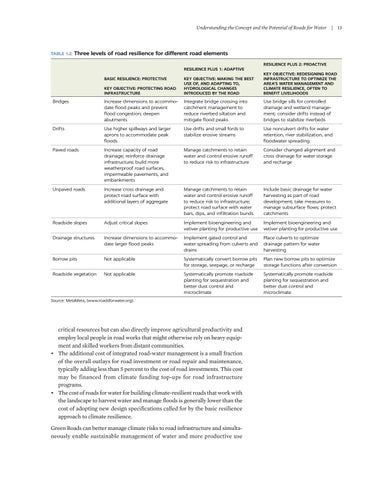Understanding the Concept and the Potential of Roads for Water | 13
TABLE 1.2 Three
levels of road resilience for different road elements RESILIENCE PLUS 1: ADAPTIVE
RESILIENCE PLUS 2: PROACTIVE
KEY OBJECTIVE: PROTECTING ROAD INFRASTRUCTURE
KEY OBJECTIVE: MAKING THE BEST USE OF, AND ADAPTING TO, HYDROLOGICAL CHANGES INTRODUCED BY THE ROAD
KEY OBJECTIVE: REDESIGNING ROAD INFRASTRUCTURE TO OPTIMIZE THE AREA’S WATER MANAGEMENT AND CLIMATE RESILIENCE, OFTEN TO BENEFIT LIVELIHOODS
Bridges
Increase dimensions to accommodate flood peaks and prevent flood congestion; deepen abutments
Integrate bridge crossing into catchment management to reduce riverbed siltation and mitigate flood peaks
Use bridge sills for controlled drainage and wetland management; consider drifts instead of bridges to stabilize riverbeds
Drifts
Use higher spillways and larger aprons to accommodate peak floods
Use drifts and small fords to stabilize erosive streams
Use nonculvert drifts for water retention, river stabilization, and floodwater spreading
Paved roads
Increase capacity of road drainage; reinforce drainage infrastructure; build more weatherproof road surfaces, impermeable pavements, and embankments
Manage catchments to retain water and control erosive runoff to reduce risk to infrastructure
Consider changed alignment and cross drainage for water storage and recharge
Unpaved roads
Increase cross drainage and protect road surface with additional layers of aggregate
Manage catchments to retain water and control erosive runoff to reduce risk to infrastructure; protect road surface with water bars, dips, and infiltration bunds
Include basic drainage for water harvesting as part of road development; take measures to manage subsurface flows; protect catchments
Roadside slopes
Adjust critical slopes
Implement bioengineering and vetiver planting for productive use
Implement bioengineering and vetiver planting for productive use
Drainage structures
Increase dimensions to accommodate larger flood peaks
Implement gated control and water spreading from culverts and drains
Place culverts to optimize drainage pattern for water harvesting
Borrow pits
Not applicable
Systematically convert borrow pits for storage, seepage, or recharge
Plan new borrow pits to optimize storage functions after conversion
Roadside vegetation
Not applicable
Systematically promote roadside planting for sequestration and better dust control and microclimate
Systematically promote roadside planting for sequestration and better dust control and microclimate
BASIC RESILIENCE: PROTECTIVE
Source: MetaMeta, (www.roadsforwater.org).
critical resources but can also directly improve agricultural productivity and employ local people in road works that might otherwise rely on heavy equipment and skilled workers from distant communities. • The additional cost of integrated road-water management is a small fraction of the overall outlays for road investment or road repair and maintenance, typically adding less than 5 percent to the cost of road investments. This cost may be financed from climate funding top-ups for road infrastructure programs. • The cost of roads for water for building climate-resilient roads that work with the landscape to harvest water and manage floods is generally lower than the cost of adopting new design specifications called for by the basic resilience approach to climate resilience. Green Roads can better manage climate risks to road infrastructure and simultaneously enable sustainable management of water and more productive use







































